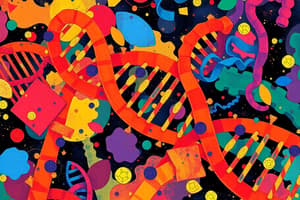Podcast
Questions and Answers
The process by which one strain of bacteria is apparently changed into another strain is called?
The process by which one strain of bacteria is apparently changed into another strain is called?
transformation
Bacteriophages are?
Bacteriophages are?
viruses
A nucleotide does NOT contain?
A nucleotide does NOT contain?
polymerase
In prokaryotes, DNA molecules are located in the?
In prokaryotes, DNA molecules are located in the?
The process of DNA?
The process of DNA?
The main enzyme involved in linking individual nucleotides into DNA molecules is?
The main enzyme involved in linking individual nucleotides into DNA molecules is?
The process by which the genetic code of DNA is copied into a strand of RNA is called?
The process by which the genetic code of DNA is copied into a strand of RNA is called?
In messenger RNA, each codon specifies a particular?
In messenger RNA, each codon specifies a particular?
Changes in the DNA that affect genetic information are known as?
Changes in the DNA that affect genetic information are known as?
An expressed gene is one that?
An expressed gene is one that?
What three critical gene functions had scientists identified?
What three critical gene functions had scientists identified?
Describe the components and structure of a DNA nucleotide.
Describe the components and structure of a DNA nucleotide.
How did Chargaff's rules help Watson and Crick model DNA?
How did Chargaff's rules help Watson and Crick model DNA?
What is meant by the term 'base pairing'?
What is meant by the term 'base pairing'?
How is base pairing involved in DNA replication?
How is base pairing involved in DNA replication?
Describe the appearance of DNA in a typical prokaryotic cell.
Describe the appearance of DNA in a typical prokaryotic cell.
Explain the process of replication.
Explain the process of replication.
When a DNA molecule is replicated, how do the new molecules relate to the original molecule?
When a DNA molecule is replicated, how do the new molecules relate to the original molecule?
Describe the relationship between DNA, chromatin, histones, and nucleosomes.
Describe the relationship between DNA, chromatin, histones, and nucleosomes.
What is the difference between exons and introns?
What is the difference between exons and introns?
What is a codon?
What is a codon?
What is an anticodon?
What is an anticodon?
How does the anticodon function?
How does the anticodon function?
If a codon on a DNA molecule for a specific amino acid is CTA, what would be the messenger RNA codon?
If a codon on a DNA molecule for a specific amino acid is CTA, what would be the messenger RNA codon?
What would be the transfer RNA anticodon for the codon CTA?
What would be the transfer RNA anticodon for the codon CTA?
Explain why controlling the proteins in an organism controls the organism's characteristics.
Explain why controlling the proteins in an organism controls the organism's characteristics.
Name two major types of mutations.
Name two major types of mutations.
What do gene mutations and chromosomal mutations have in common?
What do gene mutations and chromosomal mutations have in common?
How are gene mutations and chromosomal mutations different?
How are gene mutations and chromosomal mutations different?
Give an example of a gene mutation.
Give an example of a gene mutation.
Give an example of a chromosomal mutation.
Give an example of a chromosomal mutation.
Describe how the TATA box helps position RNA polymerase in a eukaryotic cell.
Describe how the TATA box helps position RNA polymerase in a eukaryotic cell.
Describe the role of an operon in a prokaryotic cell.
Describe the role of an operon in a prokaryotic cell.
Give an example of how an operon works.
Give an example of how an operon works.
Flashcards are hidden until you start studying
Study Notes
Transformation and Bacteriophages
- Transformation is the process where one strain of bacteria is converted into another strain.
- Bacteriophages are types of viruses that infect bacteria.
Nucleotides and DNA Structure
- A nucleotide does not contain polymerase.
- DNA in prokaryotes is located in the cytoplasm, appearing as a single, circular molecule.
DNA Replication
- DNA replication is the process of creating duplicate DNA strands.
- The main enzyme that links nucleotides into DNA is DNA polymerase.
- Replicated DNA molecules consist of one original and one new strand, making it a semiconservative process.
Transcription and RNA
- Transcription is the process of copying the genetic code from DNA into RNA.
- Each codon in messenger RNA specifies an amino acid.
- An anticodon is a set of three bases on a tRNA molecule that pairs with a specific mRNA codon.
Mutations and Gene Function
- Mutations are changes in DNA that affect genetic information.
- An expressed gene is actively transcribed into RNA, playing a role in traits and characteristics.
- Two major types of mutations are gene mutations (altering one or several nucleotides) and chromosomal mutations (affecting chromosome number or structure).
Components of a DNA Nucleotide
- A DNA nucleotide comprises a deoxyribose sugar, a phosphate group, and a nitrogenous base (adenine, thymine, guanine, cytosine).
- Chargaff's rules dictate that adenine always pairs with thymine, and cytosine pairs with guanine.
Gene Structure and Function
- Pre-RNA contains introns (non-coding sequences) that are removed during RNA processing, leaving exons (coding sequences) that produce proteins.
- The TATA box in eukaryotic cells helps position RNA polymerase, marking the transcription start site.
Operons in Prokaryotic Cells
- Operons are groups of genes and regulatory elements that control processes in prokaryotic cells, such as lactose utilization in E. coli.
Role of Proteins
- Proteins catalyze reactions and regulate growth rates and patterns, thereby influencing the characteristics of an organism.
Studying That Suits You
Use AI to generate personalized quizzes and flashcards to suit your learning preferences.




